More hot times this week from the early days of programming and into the 60’s. Styles under review will dabble with limited animation, claymation, and even anime. And please note: there are several absent embeds this week, and some hard to find – so I hope my verbal descriptions will suffice.

While not spotlighted as to occupation in very many episodes, the origins of Art Cloakey’s “Gumby” series established that Gumby’s dad (Mr. Gumba) was by trade a fireman (though there is also the suggestion from his and his wife’s free access to a doll hospital in the same premiere that they also have degrees as M.D. and nurse). Moon Trip (aka “Gumby on the Moon”) (5/1/56) marked the series’ debut over the airwaves, and is an extended-length story which ultimately had to be cut into three short episodes with repeated footage to fit into local syndication packages.
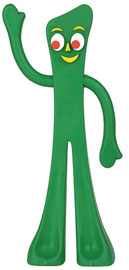 The center chapter finds Gumby, after having launched himself to the moon in a miniature spaceship found in the toy department, stranded there when his ship is mysteriously destroyed by rays from a cosmic storm. He rests against what appears to be a pyramid-shaped rock – but isn’t a rock at all, as it sprouts eyes which extend like antennae from its body, also develops a mouth, and is capable of shuffling along the moon’s surface. These moon men use their rock disguise to creep up on and surround Gumby. Gumby uses his advantage of weight six times less than normal upon the moon to jump outside of their surrounding circle and make a run for it. He ducks into a crater, but finds its walls too steep to climb back up. Plus, he is feeling the effects of the moon’s extreme cold (perhaps not scientfically accurate, as he is not on the dark side of the moon). As the moon men peer into the crater, so do two other sets of eyes – Mr. And Mts. Gumba, looking through a toy replica of the Mount Wilson telescope back home. “Yup. He’s on the moon all tight. I’ve gotta go after him”, states Gumby’s dad. Dad hurries off to the firehouse, returning with a toy hook and ladder engine just his size. He outfits himself for the mission in a heavy fur parka. Then, looking up at the moon above, he stands upon the top rung of the extension ladder, and rotates the ladder with controls at its topmost rung to face the moon. He operates more controls on his board to begin a slow ascent toward the moon upon his ladder. (Either they make these toy ladders very long, or the heavenly bodies are simply much more compact in Gumbasia.)
The center chapter finds Gumby, after having launched himself to the moon in a miniature spaceship found in the toy department, stranded there when his ship is mysteriously destroyed by rays from a cosmic storm. He rests against what appears to be a pyramid-shaped rock – but isn’t a rock at all, as it sprouts eyes which extend like antennae from its body, also develops a mouth, and is capable of shuffling along the moon’s surface. These moon men use their rock disguise to creep up on and surround Gumby. Gumby uses his advantage of weight six times less than normal upon the moon to jump outside of their surrounding circle and make a run for it. He ducks into a crater, but finds its walls too steep to climb back up. Plus, he is feeling the effects of the moon’s extreme cold (perhaps not scientfically accurate, as he is not on the dark side of the moon). As the moon men peer into the crater, so do two other sets of eyes – Mr. And Mts. Gumba, looking through a toy replica of the Mount Wilson telescope back home. “Yup. He’s on the moon all tight. I’ve gotta go after him”, states Gumby’s dad. Dad hurries off to the firehouse, returning with a toy hook and ladder engine just his size. He outfits himself for the mission in a heavy fur parka. Then, looking up at the moon above, he stands upon the top rung of the extension ladder, and rotates the ladder with controls at its topmost rung to face the moon. He operates more controls on his board to begin a slow ascent toward the moon upon his ladder. (Either they make these toy ladders very long, or the heavenly bodies are simply much more compact in Gumbasia.)
On his way up, Mr. Gumba encounters an asteroid which also nearly collided with Gumby’s ship on the way up. The rock has a face similar to the moon’s but evil in expression, and attempts to blow a blast of icy air at Mr. Gumba. Mr. Gumba quickly retaliates by spraying the asteroid with an aerosol can of fire extinguisher. The asteroid’s breath trail ceases, and the semi-paralyzed rock drifts out of the way. Mr. Gumba continues his slow approach toward the moon’s surface, now close enough to take in a panoramic view of its crags and craters. “In here, dad”, calls out Gumby from one of the larger holes. A POV shot from Gumby’s view shows father riding the ladder in upside down. “How did you get up there?”, hollers Gumby, while Papa tells him not to worry. Meanwhile, the rock men have been slipping down into the crater, using rope lines tied around their centers to lower themselves to the crater floor. Just as Mr. Gumba’s ladder touches the surface, so do the moon men arrive. Gumby shouts a warning as they begin to creep up behind Dad. “They’re only pretending to be stone.” Mr. Gumba looks around. Three nearby “stones” are motionless – but one pops his eyes into visibility, and shouts unintelligible orders to the others, revealing the ruse. Mr. Gumba reaches for his trusty can of extinguisher again, dousing the commander in icy foam, and paralyzing him in place. Dad turns the can toward the others, but they turn tail and shimmy away in fright. Victory seems assured – but Gumby chooses this moment to fall unconscious and rigid from the cold. Mr. Gumba gently picks up the boy, wraps Gumby up with him inside his own parka as best he can, and carries the boy aboard the ladder, for the slow descent down to Earth. An extended clay mock-up of medical procedure shows follows at the Doll Hospital, with Gumby treated with electrical heating rays in a full body chamber, until his temperature reading says “Perfect”, and he regains consciousness and opens his eyes. “I was on the moon”, he says to his parents (as the ball bearing representing Gumby’s eye falls out of position in a glaring animation error), “but I’m sure glad to be back.”
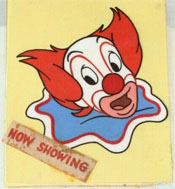 Absent as usual from availability for review is Larry Harmon’s run of Bozo the Clown cartoons, including a pretty likely candidate for inclusion here, Fire Fighter Flyer, and another possible, Okey Dokey Smokey, both circa 1959. No information of plotline on these titles appears to be available on the net – so any that readers might provide will prove invaluable. It is also of note that the early run of Bozo cartoons featured credits in which Bozo was shot out of a cannon, sailed across the circus tent, and would land upon the tail end of a clown-car hook and ladder vehicle speeding across the sawdust floor, the scene fading to black amidst rising smoke billows and wailing sirens, to fade in to the title of the current episode.
Absent as usual from availability for review is Larry Harmon’s run of Bozo the Clown cartoons, including a pretty likely candidate for inclusion here, Fire Fighter Flyer, and another possible, Okey Dokey Smokey, both circa 1959. No information of plotline on these titles appears to be available on the net – so any that readers might provide will prove invaluable. It is also of note that the early run of Bozo cartoons featured credits in which Bozo was shot out of a cannon, sailed across the circus tent, and would land upon the tail end of a clown-car hook and ladder vehicle speeding across the sawdust floor, the scene fading to black amidst rising smoke billows and wailing sirens, to fade in to the title of the current episode.
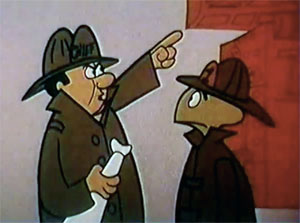 Fired Fireman (or Hook and Batter) (Total Television, Tooter Turtle (King Leonardo and His Short Subjects), 1960-61 season) – Tooter Turtle, as usual, again wats to try out a new vocation, with the magical help of Mister Wizard the Lizard. A wave of a wand, and Tooter is cast in the role of a fireman. Tooter pulls the old trick of going right through the floor when sliding down the fire pole, then mans the wheel at the rear end of the engine. As the engine reaches each corner, Tooter spins his wheel. “Round and round she goes, and where she stops, nobody knows.” Certainly true, as he smashes himself and the end of the hose into a lamppost. Arriving at the fire scene, Tooter is informed by the chief that a boy is stranded in an upper story apartment. Tooter races up numerous staircases until nearly exhausted, only to find the apartment door locked. He rears back to batter down the door, not realizing the boy inside is about to unlock it. Tooter rushes right through the apartment, out the window, and dangles from a flagpole outside. “Don’t know my own strength”, he mutters. Below, the crew waits with a safety net, and Tooter announces he’s coming down. He lets go of the flagpole – failing to notice there is another one directly under him. He bounces like a pinball between the two poles, then off about seven more flagpoles at different positions on the building on the way dowm, finally missing the net ad crashing through the pavement. “That was a real flop, Tooter” says the chief. Tooter asks to use the extension ladder. The chief remarks it’s getting pretty hot up there, and as a precaution tells the crew to wet Tooter down. They turn the hose upon him. Tooter lies in a puddle on the pavement, remarking “He said wet me down, not knock me down.” Tooter reaches the elevation of the boy’s window, but the ladder isn’t close enough to the building, leaving Tooter dangling between the window ledge and the top rung. Flipping himself back upon the ladder, he extends his foot to straddle the distance between ladder and window – but has the window sam shut on one foot. By the time he gets inside, he can’t find the kid (who may have made a trip to the little boy’s room). Tooter looks inside a closet for him, while the boy re-enters the room through an adjoining door, pushing the closet door shut behind Tooter. Seeing another fireman on the ladder outside, the kid escapes to safety with him – leaving Tooter shut inside the closet, unable to get the door open. Flames rise from the floorboards, setting Tooter’s pants afire. “Help, Mr. Wizard! I’m burning my britches. I’m a cooked goose!”. As always, another wand wave, and it’s “Drizzle drazzle druzzle drome, time for this one to come home.”
Fired Fireman (or Hook and Batter) (Total Television, Tooter Turtle (King Leonardo and His Short Subjects), 1960-61 season) – Tooter Turtle, as usual, again wats to try out a new vocation, with the magical help of Mister Wizard the Lizard. A wave of a wand, and Tooter is cast in the role of a fireman. Tooter pulls the old trick of going right through the floor when sliding down the fire pole, then mans the wheel at the rear end of the engine. As the engine reaches each corner, Tooter spins his wheel. “Round and round she goes, and where she stops, nobody knows.” Certainly true, as he smashes himself and the end of the hose into a lamppost. Arriving at the fire scene, Tooter is informed by the chief that a boy is stranded in an upper story apartment. Tooter races up numerous staircases until nearly exhausted, only to find the apartment door locked. He rears back to batter down the door, not realizing the boy inside is about to unlock it. Tooter rushes right through the apartment, out the window, and dangles from a flagpole outside. “Don’t know my own strength”, he mutters. Below, the crew waits with a safety net, and Tooter announces he’s coming down. He lets go of the flagpole – failing to notice there is another one directly under him. He bounces like a pinball between the two poles, then off about seven more flagpoles at different positions on the building on the way dowm, finally missing the net ad crashing through the pavement. “That was a real flop, Tooter” says the chief. Tooter asks to use the extension ladder. The chief remarks it’s getting pretty hot up there, and as a precaution tells the crew to wet Tooter down. They turn the hose upon him. Tooter lies in a puddle on the pavement, remarking “He said wet me down, not knock me down.” Tooter reaches the elevation of the boy’s window, but the ladder isn’t close enough to the building, leaving Tooter dangling between the window ledge and the top rung. Flipping himself back upon the ladder, he extends his foot to straddle the distance between ladder and window – but has the window sam shut on one foot. By the time he gets inside, he can’t find the kid (who may have made a trip to the little boy’s room). Tooter looks inside a closet for him, while the boy re-enters the room through an adjoining door, pushing the closet door shut behind Tooter. Seeing another fireman on the ladder outside, the kid escapes to safety with him – leaving Tooter shut inside the closet, unable to get the door open. Flames rise from the floorboards, setting Tooter’s pants afire. “Help, Mr. Wizard! I’m burning my britches. I’m a cooked goose!”. As always, another wand wave, and it’s “Drizzle drazzle druzzle drome, time for this one to come home.”
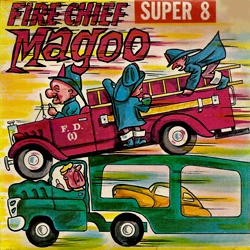 Fire Chief Magoo (UPA, The Mister Magoo Show – Paul Fennell, dir.) – Magoo receives a circular from a boy scout at his door about Fire Prevention Week. He believes it is an official appointment of himself as new fire chief. He reports to the local station (Firehouse 5 plus 2 – did Ward Kimball ever get word of this?), surprising the existing chief, who thinks he’s being replaced. Magoo takes immediate steps to spruce up the place, ordering the removal of “oil spots” (actually the spots on the coat of the station’s dalmatian). An alarm clock sounds on the stove of the firehouse, intended to remind the chief to turn the heat off of a pressure cooker befire his stew blows up. Magoo interprets it as a fire alarm, seizing the chief away from the stove to answer the call. Magoo hops in the driver’s cab of the engine, dragging along the chief on the ladder end of the vehicle. Condescendingly, the chief asks Magoo the vital question: “Where’s the fire?” Magoo peers around, and discovers the scene of a standoff between police cars and some bandits in an upper-story window, gunfire ringing ad small puffs of gunsmoke emitting from the barrels pointed out the window. “Where there’s smoke…”, thinks Magoo, and charges into the crime scene. Pulling a lever on the engine, Magoo rides the extension ladder toward the open window, carrying a fire hose. “Hey, what’s with the hook and ladder?”, observes the leader of the crooks inside, and orders his henchmen to “pour it on”, which they do with machine gun fire. While portions of the ladder are being shot out from under him. Magoo miraculously remains unhit, and interprets the passing bullets as sign that the wind is changing. He overshoots past the window to the chimney above, and turns on the hose into the building. The crooks gasp and sputter about in the water, as the police chief outside comments that he hopes Magoo doesn’t drown them, as there’s a reward for them alive. Magoo chops at the side wall of the house with an axe, opening a gap out of which pours the water that has filled the room, and the crooks, all of which are caught in a firemen’s net by the chief and several of the cops below. Magoo is certain he’ll get a medal for this quick rescue, and drives the old fire chief back to the station. Oddly, he can still smell smoke. Small wonder, as the station is reduced to matchsticks, the chief not a bit surprised. “My stew blew”, he protests to Magoo. But Magoo, oblivious of the condition of the station, announces there are more important things to do, like continue with the station’s cleanup – entering a next-door antique shop instead of the firehouse, and tossing every valuable object out the window, for the iris out.
Fire Chief Magoo (UPA, The Mister Magoo Show – Paul Fennell, dir.) – Magoo receives a circular from a boy scout at his door about Fire Prevention Week. He believes it is an official appointment of himself as new fire chief. He reports to the local station (Firehouse 5 plus 2 – did Ward Kimball ever get word of this?), surprising the existing chief, who thinks he’s being replaced. Magoo takes immediate steps to spruce up the place, ordering the removal of “oil spots” (actually the spots on the coat of the station’s dalmatian). An alarm clock sounds on the stove of the firehouse, intended to remind the chief to turn the heat off of a pressure cooker befire his stew blows up. Magoo interprets it as a fire alarm, seizing the chief away from the stove to answer the call. Magoo hops in the driver’s cab of the engine, dragging along the chief on the ladder end of the vehicle. Condescendingly, the chief asks Magoo the vital question: “Where’s the fire?” Magoo peers around, and discovers the scene of a standoff between police cars and some bandits in an upper-story window, gunfire ringing ad small puffs of gunsmoke emitting from the barrels pointed out the window. “Where there’s smoke…”, thinks Magoo, and charges into the crime scene. Pulling a lever on the engine, Magoo rides the extension ladder toward the open window, carrying a fire hose. “Hey, what’s with the hook and ladder?”, observes the leader of the crooks inside, and orders his henchmen to “pour it on”, which they do with machine gun fire. While portions of the ladder are being shot out from under him. Magoo miraculously remains unhit, and interprets the passing bullets as sign that the wind is changing. He overshoots past the window to the chimney above, and turns on the hose into the building. The crooks gasp and sputter about in the water, as the police chief outside comments that he hopes Magoo doesn’t drown them, as there’s a reward for them alive. Magoo chops at the side wall of the house with an axe, opening a gap out of which pours the water that has filled the room, and the crooks, all of which are caught in a firemen’s net by the chief and several of the cops below. Magoo is certain he’ll get a medal for this quick rescue, and drives the old fire chief back to the station. Oddly, he can still smell smoke. Small wonder, as the station is reduced to matchsticks, the chief not a bit surprised. “My stew blew”, he protests to Magoo. But Magoo, oblivious of the condition of the station, announces there are more important things to do, like continue with the station’s cleanup – entering a next-door antique shop instead of the firehouse, and tossing every valuable object out the window, for the iris out.
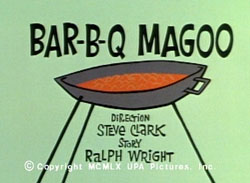 Bar-B-Q Magoo (UPA, The Mister Magoo Show – Steve Clark, dir.) – Magoo designs and constructs his own style of backyard barbecue – a rickety, trembling amassing of loose bricks and dripping mortar, barely able to stand. It collapses, but conveniently reassembles into what looks like a traditional barbecue, but missing the grill. Magoo claims he has that licked too, with an old wheelbarrow he purchased that he believes will be a perfect setting for the charcoal. It is, in fact, a real barbecue grill, much to the surprise of Magoo’s Asiatic houseboy Cholly. Everything looks set for a real barbecue after all – but the guest list is likely to be a little large, as Magoo grabs a city telephone book instead of his book of numbers for his old school chums, and instructs Cholly to call everybody on the list. Next, Magoo’s garden hose is found by the camera to be chopped into small bits, which Magoo believes are green hickory limbs to flavor the fire. Intending to add a drop of petrol to begin the blaze, he instead dampens the grill with water from a sprinkling can, so his matches won’t burn. Determined to get the fire lit, Magoo goes to his garage for an old box of “kindling” – actually, fireworks. As Cholly appears with the steaks, Magoo prepares to light the fuses. “Your fireworks!” shouts Cholly. “Of course my fire works”, responds Magoo, announcing that he expects it to ignite immediately. Of this, Cholly has no doubt – as a first skyrocket whizzes past him, carrying off the steaks. Cholly tells Magoo that his steaks have gone sky high. Magoo agrees, and recollects the days when you could get them for fifteen cents a pound.
Bar-B-Q Magoo (UPA, The Mister Magoo Show – Steve Clark, dir.) – Magoo designs and constructs his own style of backyard barbecue – a rickety, trembling amassing of loose bricks and dripping mortar, barely able to stand. It collapses, but conveniently reassembles into what looks like a traditional barbecue, but missing the grill. Magoo claims he has that licked too, with an old wheelbarrow he purchased that he believes will be a perfect setting for the charcoal. It is, in fact, a real barbecue grill, much to the surprise of Magoo’s Asiatic houseboy Cholly. Everything looks set for a real barbecue after all – but the guest list is likely to be a little large, as Magoo grabs a city telephone book instead of his book of numbers for his old school chums, and instructs Cholly to call everybody on the list. Next, Magoo’s garden hose is found by the camera to be chopped into small bits, which Magoo believes are green hickory limbs to flavor the fire. Intending to add a drop of petrol to begin the blaze, he instead dampens the grill with water from a sprinkling can, so his matches won’t burn. Determined to get the fire lit, Magoo goes to his garage for an old box of “kindling” – actually, fireworks. As Cholly appears with the steaks, Magoo prepares to light the fuses. “Your fireworks!” shouts Cholly. “Of course my fire works”, responds Magoo, announcing that he expects it to ignite immediately. Of this, Cholly has no doubt – as a first skyrocket whizzes past him, carrying off the steaks. Cholly tells Magoo that his steaks have gone sky high. Magoo agrees, and recollects the days when you could get them for fifteen cents a pound.
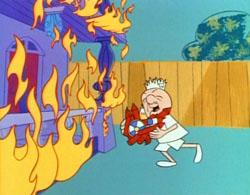 Magoo begins to notice the rockets flying round him, and complains about those “dratted low-flying airplanes”. A rocket soars over the house, igniting the front porch. Cholly informs Magoo that one of his “sparks” has made a home upon his home. Magoo decides to add a little water to keep the sparks from flaring up on the grill, pouring on the fire his gasoline can instead. An explosion blows away the bottom two-third of the can, Magoo believing his watering can is rusting away. The flame spreads upon Magoo’s house, calling the attention of the fire department. The crew charges into Magoo’s backyard, carrying a hose. Magoo mistakes the fire chief for his old school chum Fenwick, and the hose for Magoo’s apetite favorite – salami. He slices himself off a big chunk – severing the nozzle from the hose, causing himself to be splashed with water. “Same ol’ Fenwick”, responds Magoo, believing he has been doused with a practical joke squirting flower. Magoo really heats up the party, by stoking the fire further – with more skyrockets thrown upon his now blazing rear porch. As rockets fly everywhere, Magoo believes his school chums and Cholly have learned to talk like beatniks, as they refer to him as “Crazy, man, crazy!”
Magoo begins to notice the rockets flying round him, and complains about those “dratted low-flying airplanes”. A rocket soars over the house, igniting the front porch. Cholly informs Magoo that one of his “sparks” has made a home upon his home. Magoo decides to add a little water to keep the sparks from flaring up on the grill, pouring on the fire his gasoline can instead. An explosion blows away the bottom two-third of the can, Magoo believing his watering can is rusting away. The flame spreads upon Magoo’s house, calling the attention of the fire department. The crew charges into Magoo’s backyard, carrying a hose. Magoo mistakes the fire chief for his old school chum Fenwick, and the hose for Magoo’s apetite favorite – salami. He slices himself off a big chunk – severing the nozzle from the hose, causing himself to be splashed with water. “Same ol’ Fenwick”, responds Magoo, believing he has been doused with a practical joke squirting flower. Magoo really heats up the party, by stoking the fire further – with more skyrockets thrown upon his now blazing rear porch. As rockets fly everywhere, Magoo believes his school chums and Cholly have learned to talk like beatniks, as they refer to him as “Crazy, man, crazy!”
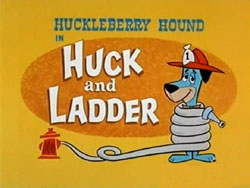 We’ll next return to some more work from Hanna-Barbera. One of our readers reminded me of a later Huckleberry Hound installment, Huck and Ladder (12/1/61). This one had slipped my recollection, as many of the last Huckleberrys were not packaged in the amalgam that local station KTTV in Los Angeles called The Yogi Bear Show during my childhood, which combined all elements of the Yogi and Huck half-hours into one package. There were not enough Yogis to go around to splice onto the same reels with the other cartoons, so many episodes of the associated characters went by the wayside without screenings, and I beleive this was one of them. I seem to recall only occasional sightings of this title once Ted Turner acquired the rights to the H-B library, and it didn’t have the staying power of the earlier “Fireman Huck”. In fact, it almost feels like a mashup of two of the earlier cartoons of the run – the aforementioned Fireman Huck, and Huckleberry Hound Meets Wee Willie, involving officer Huckleberry versus an escaped gorilla. The writers may have been running out of ideas for their blue hound, leading to repetition as a means of filling quota.
We’ll next return to some more work from Hanna-Barbera. One of our readers reminded me of a later Huckleberry Hound installment, Huck and Ladder (12/1/61). This one had slipped my recollection, as many of the last Huckleberrys were not packaged in the amalgam that local station KTTV in Los Angeles called The Yogi Bear Show during my childhood, which combined all elements of the Yogi and Huck half-hours into one package. There were not enough Yogis to go around to splice onto the same reels with the other cartoons, so many episodes of the associated characters went by the wayside without screenings, and I beleive this was one of them. I seem to recall only occasional sightings of this title once Ted Turner acquired the rights to the H-B library, and it didn’t have the staying power of the earlier “Fireman Huck”. In fact, it almost feels like a mashup of two of the earlier cartoons of the run – the aforementioned Fireman Huck, and Huckleberry Hound Meets Wee Willie, involving officer Huckleberry versus an escaped gorilla. The writers may have been running out of ideas for their blue hound, leading to repetition as a means of filling quota.
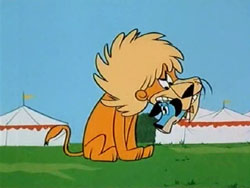 Colonel Cornball, owner of a circus, has a problem. A gorilla has gotten loose inside the big top. The customers have fled – and stay so, as the gorilla refuses to come out or be captured. A circus roustabout (whom the Colonel always calls “Rube”, even though his real name is Cicero) suggests maybe he should call the fire department, as they’re good at helping anumals like getting cats out of trees, etc. A call us placed to Huck’s station. When Huck hears that an animal is in distress, he inquires, “What kind?” He gets an evasive answer, with Huck left to express that he only asked to satisfy his curiosity. The Colonel gets Huck to admit the department doesn’t discriminate in giving aid – an animal is an animal – then quietly lays the bombshell at the end of the call that it’s a gorilla, after Huck has already blurted out that he’ll be right down. Dawn breaks only after Huck has hung up the phone, and Huck realizes he’s sworn to uphold the reputation of the Department by fulfilling his promise. He arrives with his hook and ladder truck, and the Colonel explains the situation of why the customers won’t come. “I detect a slight hint of commercialism, Colonel”, notes Huck. “That’s right, son”, responds the Colonel, “It isn’t laughs we’re workin’ for, its loot!” Huck checks to see if the ape is still in the tent, receiving a quick answer in the form of a sock in the jaw from a hairy hand. Now formally introduced, Huck walks in as “your old pal, Huckleberry”, and receives another sock through the canvas of the big top. Landing on the ground outside with a thud, Huck speculates as to what would have happened if he wasn’t “your old pal Huckleberry.”
Colonel Cornball, owner of a circus, has a problem. A gorilla has gotten loose inside the big top. The customers have fled – and stay so, as the gorilla refuses to come out or be captured. A circus roustabout (whom the Colonel always calls “Rube”, even though his real name is Cicero) suggests maybe he should call the fire department, as they’re good at helping anumals like getting cats out of trees, etc. A call us placed to Huck’s station. When Huck hears that an animal is in distress, he inquires, “What kind?” He gets an evasive answer, with Huck left to express that he only asked to satisfy his curiosity. The Colonel gets Huck to admit the department doesn’t discriminate in giving aid – an animal is an animal – then quietly lays the bombshell at the end of the call that it’s a gorilla, after Huck has already blurted out that he’ll be right down. Dawn breaks only after Huck has hung up the phone, and Huck realizes he’s sworn to uphold the reputation of the Department by fulfilling his promise. He arrives with his hook and ladder truck, and the Colonel explains the situation of why the customers won’t come. “I detect a slight hint of commercialism, Colonel”, notes Huck. “That’s right, son”, responds the Colonel, “It isn’t laughs we’re workin’ for, its loot!” Huck checks to see if the ape is still in the tent, receiving a quick answer in the form of a sock in the jaw from a hairy hand. Now formally introduced, Huck walks in as “your old pal, Huckleberry”, and receives another sock through the canvas of the big top. Landing on the ground outside with a thud, Huck speculates as to what would have happened if he wasn’t “your old pal Huckleberry.”
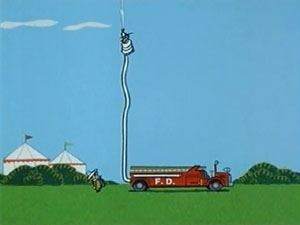 Huck breaks out the fire hose, intent on cooling the gorilla off. (This cartoon is a real cheater on animation, as we haven’t even seen the gorilla yet except for a momentary show of his fist – and still don’t as Huck enters the tent.) A scuffle is heard but not seen inside, only visually represented by several jerks on the hose, and Huck is tossed out, knotted up in the canvas hose, and bobbing high up in the air at hose end as the water gushes like a fountain from the nozzle. Huck asks the Colonel to turn off the water – which the Colonel does all the way, letting Huck fall to the ground. “I shoulda said, gradual, like”, moans Huck. “We’re making progress”, Huck next observes, stating that the gorilla’s thinking process is emerging, and operational pattern is taking shape. “In other words – he’s smarter than we are.” But Huck vows to think liike a gorilla, and approaches walking on his arms in the manner of an ape. The writing hits a convenient inconsistency, as the gorilla, formerly noted as refusing to leave the tent, is suddenly seen outside. (Doesn’t this already solve part of the Colonel’s problem without Huck’s intervention?) Huck engages in a game of “Monkey see, monkey do”, luring the ape back to his cage. Huck goes in the door, but the gorilla stops outside in confusion. Huck demonstrates again, re-entering the cage door. The gorilla ambles up to the door, bit merely locks it upon Huck. As Huck begs for the ape to let him out, Rube runs into the scene to tell the Colonel that a lion has also gotten loose. The beast charges into the area, and the ape thinks better about his and Huck’s respective positions, opening the cage door to admit himself in – and toss Huck out. Huck pounds on the cage door again, but from the opposite side to be let in – but the ape won’t share living quarters. Before Huck knows it, he is being shaken around while clenched in the lion’s jaws. Suddenly, a fire alarm is heard from the station. Huck notes his overriding duty to drop whatever he is doing and answer the call of the fire bell under all circumstances – and pries himself loose of the lion, making an escape to his engine. Huck is thankful for that department rule, because in this case, he was really “saved by the bell.”
Huck breaks out the fire hose, intent on cooling the gorilla off. (This cartoon is a real cheater on animation, as we haven’t even seen the gorilla yet except for a momentary show of his fist – and still don’t as Huck enters the tent.) A scuffle is heard but not seen inside, only visually represented by several jerks on the hose, and Huck is tossed out, knotted up in the canvas hose, and bobbing high up in the air at hose end as the water gushes like a fountain from the nozzle. Huck asks the Colonel to turn off the water – which the Colonel does all the way, letting Huck fall to the ground. “I shoulda said, gradual, like”, moans Huck. “We’re making progress”, Huck next observes, stating that the gorilla’s thinking process is emerging, and operational pattern is taking shape. “In other words – he’s smarter than we are.” But Huck vows to think liike a gorilla, and approaches walking on his arms in the manner of an ape. The writing hits a convenient inconsistency, as the gorilla, formerly noted as refusing to leave the tent, is suddenly seen outside. (Doesn’t this already solve part of the Colonel’s problem without Huck’s intervention?) Huck engages in a game of “Monkey see, monkey do”, luring the ape back to his cage. Huck goes in the door, but the gorilla stops outside in confusion. Huck demonstrates again, re-entering the cage door. The gorilla ambles up to the door, bit merely locks it upon Huck. As Huck begs for the ape to let him out, Rube runs into the scene to tell the Colonel that a lion has also gotten loose. The beast charges into the area, and the ape thinks better about his and Huck’s respective positions, opening the cage door to admit himself in – and toss Huck out. Huck pounds on the cage door again, but from the opposite side to be let in – but the ape won’t share living quarters. Before Huck knows it, he is being shaken around while clenched in the lion’s jaws. Suddenly, a fire alarm is heard from the station. Huck notes his overriding duty to drop whatever he is doing and answer the call of the fire bell under all circumstances – and pries himself loose of the lion, making an escape to his engine. Huck is thankful for that department rule, because in this case, he was really “saved by the bell.”
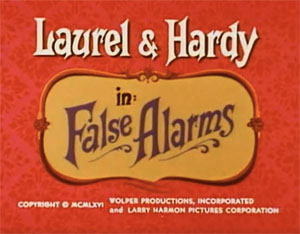 For once, a Laurel and Hardy cartoon, produced by Hanna-Barbera under contract for syndication by Larry Harmon and Wolper Productions on the mid-1960’s, was actually located to discuss. False Alarms finds the boys as firemen, wearing characteristic hats and slickers instead of their usual suits and derbies, Their chief asks them to give the station a new coat of paint while he is away for a few hours. Laurel promises a new coat, and a pair of pants to boot, leaving the chief to only mutter a resigned “Uh huh” in underplay, obviously used to such senseless remarks from Stan. Laurel lowers a rope from a second story window, on the other end of which sits Ollie riding a scaffold as he performs his task. The station telephone rings, and Hardy order Stan to answer it, “But Ollie,…” gently complains Stan, knowing what will happen. He finally runs for the call, letting go of the rope, to leave Ollie in a puddle of red paint, crash-landed on the pavement below. “You don’t say? Tsk tsk”, says Laurel on his end of the call, telling the caller that they’re pretty busy at the moment, but to have a nice day. Of course, when Ollie climbs to the window to see who it was, Laurel reveals it was someone reporting a fire. Ollie panics, informing Stan that it’s their duty to answer it. They slide down the fire pole, Laurel landing on top of Ollie, driving the both of them through the floor into the basement. They finally make it aboard the engine, but Stan winds up dangling from the trailing nozzle of the fire hose behind the engine. Hardy puts on the brakes, letting Stan sail over his head, through the engine windshield, and crash land into a light pole, bending it into a silhouette image of Stan himself. They arrive at a high rise with black smoke coming from n upper story window. Stan cranks Ollie upwards on the extension ladder, but manages to have the ladder make unexpected turns and twists, in one corner window and out another through floor after floor, finally driving Ollie upwards into a smokestack on the building roof. “Get me down” shouts Ollie. Stan cranks backward at double speed, letting Ollie crash through the bottom of the engine chassis. Ollie next has Stan hook up a hose to the hydrant, going through the old verbal misunderstanding bit with Stan of instructing him to turn on the water “When I say ready”. Stan of course louses up the cue, launching Ollie and the hose up to the smoke-filled window. Inside, as in “Popeye the Fireman”, the source of the smoke is merely the chief lighting up a large pipe in his apartment. He receives a blast of water from Ollie for his troubles, and orders, “Turn off that water!” The command is relayed by Ollie to Stan, and Stan as usual shuts off the flow altogether, letting Hardy fall. But Stan produces a safety net, which is in actuality a spring-based trampoline. Hardy lands hard upon it, and is shot back upwards, hitting his head on a flagpole above. He becomes caught in an endless repetition of bounces off the trampoline and pole, while Stam resigns himself to the usual ending. “I know Ollie…This is another fine mess I’ve gotten you into”, and whimpers his usual cry for the fade out.
For once, a Laurel and Hardy cartoon, produced by Hanna-Barbera under contract for syndication by Larry Harmon and Wolper Productions on the mid-1960’s, was actually located to discuss. False Alarms finds the boys as firemen, wearing characteristic hats and slickers instead of their usual suits and derbies, Their chief asks them to give the station a new coat of paint while he is away for a few hours. Laurel promises a new coat, and a pair of pants to boot, leaving the chief to only mutter a resigned “Uh huh” in underplay, obviously used to such senseless remarks from Stan. Laurel lowers a rope from a second story window, on the other end of which sits Ollie riding a scaffold as he performs his task. The station telephone rings, and Hardy order Stan to answer it, “But Ollie,…” gently complains Stan, knowing what will happen. He finally runs for the call, letting go of the rope, to leave Ollie in a puddle of red paint, crash-landed on the pavement below. “You don’t say? Tsk tsk”, says Laurel on his end of the call, telling the caller that they’re pretty busy at the moment, but to have a nice day. Of course, when Ollie climbs to the window to see who it was, Laurel reveals it was someone reporting a fire. Ollie panics, informing Stan that it’s their duty to answer it. They slide down the fire pole, Laurel landing on top of Ollie, driving the both of them through the floor into the basement. They finally make it aboard the engine, but Stan winds up dangling from the trailing nozzle of the fire hose behind the engine. Hardy puts on the brakes, letting Stan sail over his head, through the engine windshield, and crash land into a light pole, bending it into a silhouette image of Stan himself. They arrive at a high rise with black smoke coming from n upper story window. Stan cranks Ollie upwards on the extension ladder, but manages to have the ladder make unexpected turns and twists, in one corner window and out another through floor after floor, finally driving Ollie upwards into a smokestack on the building roof. “Get me down” shouts Ollie. Stan cranks backward at double speed, letting Ollie crash through the bottom of the engine chassis. Ollie next has Stan hook up a hose to the hydrant, going through the old verbal misunderstanding bit with Stan of instructing him to turn on the water “When I say ready”. Stan of course louses up the cue, launching Ollie and the hose up to the smoke-filled window. Inside, as in “Popeye the Fireman”, the source of the smoke is merely the chief lighting up a large pipe in his apartment. He receives a blast of water from Ollie for his troubles, and orders, “Turn off that water!” The command is relayed by Ollie to Stan, and Stan as usual shuts off the flow altogether, letting Hardy fall. But Stan produces a safety net, which is in actuality a spring-based trampoline. Hardy lands hard upon it, and is shot back upwards, hitting his head on a flagpole above. He becomes caught in an endless repetition of bounces off the trampoline and pole, while Stam resigns himself to the usual ending. “I know Ollie…This is another fine mess I’ve gotten you into”, and whimpers his usual cry for the fade out.
 Soggy To Me (Hanna-Barbera, Motormouse and Autocat (Catanooga Cats Show), 10/18/69). Motormouse and Autocat was a late entry into Hanna-Barbera’s “funny animal” tradition of short comedies, and seems to have been largely forgotten over time. However, it is at least this writer’s opinion that the series has been sadly neglected. Unlike its stablemate from the same season, “It’s the Wolf”, which mired itself into such predictable formula as to be virtually unwatchable, M&A strove as much as possible within its basic storyline parameters for variety and inventiveness – the latter rising to a level of “genius” nearly parallel to Wile E Coyote. There is definite Warner inspiration in the series, about a 9-to-5 professional mouse exterminator, who also happens to be the mechanical whiz in automotive design, and a demon in use of the monkey wrench and socket set. Give this cat an inspiration, and it’ll only take him a matter of minutes to an hour to rivet, screw, weld and cement any automotive components he can get his hands on into glistening steel free-wheeling reality. The prey for which he is hired to perform his daily labors? One Motormouse – a redneck-dialect, crash helmeted, speedster who has taken up residence in the walls of the Spin Your Wheels Garage, his favorite pastime being to attempt to break all land speed records with his souped-up miniature chopper bike, which he keeps in top-tuned condition and always at the ready inside his mousehole. Unlike most mice, Motormouse seems rarely in the mood for stealing food or other petty larceny associated with Jerry or Pixie and Dixie. He’d rather just burn rubber, leave tire tracks upon Autocat’s face, and feel the wind in his fur as a rolling free spirit – still making him a general pest to have whizzing in and out of the garage all the time. Autocat, sharing a trait with Sam Sheepdog and Ralph Wolf from Chuck Jones’ library of characters, punches the clock promptly at 9, eager to perform his work – though he is usually so worn out by the end of the day, he is equally anxious to clock out of his professional role at 5. Off the clock, during break time or after hours, he an Motormouse seem to maintain a complex relationship of general tolerance, Motormouse inquiring with all due respect how Autocat’s day is going, and Autocat sometimes even asking Motormouse for a casual favor out of friendship after a hard day, even though he’s spent his requisite eight hours doing his best to pulverize the rodent. There is no life-ling motto of “I hate meeces to pieces” here, and Motormouse admires Autocat’s professionalism – even if it does constantly get in his way. The matchup of the two personalities thus provides for many interesting writing possibilities.
Soggy To Me (Hanna-Barbera, Motormouse and Autocat (Catanooga Cats Show), 10/18/69). Motormouse and Autocat was a late entry into Hanna-Barbera’s “funny animal” tradition of short comedies, and seems to have been largely forgotten over time. However, it is at least this writer’s opinion that the series has been sadly neglected. Unlike its stablemate from the same season, “It’s the Wolf”, which mired itself into such predictable formula as to be virtually unwatchable, M&A strove as much as possible within its basic storyline parameters for variety and inventiveness – the latter rising to a level of “genius” nearly parallel to Wile E Coyote. There is definite Warner inspiration in the series, about a 9-to-5 professional mouse exterminator, who also happens to be the mechanical whiz in automotive design, and a demon in use of the monkey wrench and socket set. Give this cat an inspiration, and it’ll only take him a matter of minutes to an hour to rivet, screw, weld and cement any automotive components he can get his hands on into glistening steel free-wheeling reality. The prey for which he is hired to perform his daily labors? One Motormouse – a redneck-dialect, crash helmeted, speedster who has taken up residence in the walls of the Spin Your Wheels Garage, his favorite pastime being to attempt to break all land speed records with his souped-up miniature chopper bike, which he keeps in top-tuned condition and always at the ready inside his mousehole. Unlike most mice, Motormouse seems rarely in the mood for stealing food or other petty larceny associated with Jerry or Pixie and Dixie. He’d rather just burn rubber, leave tire tracks upon Autocat’s face, and feel the wind in his fur as a rolling free spirit – still making him a general pest to have whizzing in and out of the garage all the time. Autocat, sharing a trait with Sam Sheepdog and Ralph Wolf from Chuck Jones’ library of characters, punches the clock promptly at 9, eager to perform his work – though he is usually so worn out by the end of the day, he is equally anxious to clock out of his professional role at 5. Off the clock, during break time or after hours, he an Motormouse seem to maintain a complex relationship of general tolerance, Motormouse inquiring with all due respect how Autocat’s day is going, and Autocat sometimes even asking Motormouse for a casual favor out of friendship after a hard day, even though he’s spent his requisite eight hours doing his best to pulverize the rodent. There is no life-ling motto of “I hate meeces to pieces” here, and Motormouse admires Autocat’s professionalism – even if it does constantly get in his way. The matchup of the two personalities thus provides for many interesting writing possibilities.
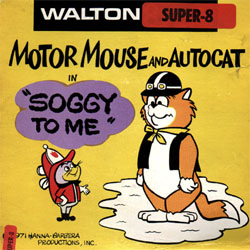 Several other factors set this series apart from most of H-B’s offerings of the late ‘60’s and following. Excellent voice reads are provided for Autocat by veteran TV comedian Marty Ingles (former star of I’m Dickens, He’s Fester with John Astin before he became Gomez Addams). Ingles would subsequently assume other H-B voice roles as Pac-Man and as the canine compadre to Grape Ape – but neither role seemed to provide him with the variety of opportunities for winning punch lines that M&A did. Writing is reasonably top-notch, at least in comparison to the studio’s other offerings, and takes great pains to avoid repetition of material from prior series. To date, only one episode I have noted fell back upon an old scenario – mirroring the mentoring of a kitten as formerly used in “Professor Tom” and “Jinks Junior”. Yet, other situations which might have easily lent themselves to repetition, such as a visiting Texas relative (harkening to “Pecos Pest” or “Cousin Tex”) are handled with new gags and dialogue, none seemingly lifted from the prior productions. Finally, a major hurdle is overcome that dashed to the ground much of the potential of H-B’s previous attempt at inventiveness, “Dastardly and Muttley In Their Flying Machines.” As discussed in a prior article. D&M suffered from a combination of budget restrictions and potential designer’s-block, that restricted each episode’s use of newly-designed lethal aerial weaponry to only one or two models per episode – requiring inordinate stretching of story material to fill time between the inventions, and slowing the pace markedly. In contrast, M&A may have benefitted from a substantially higher budget – and every dollar shows on the screen. Autocat’s new masterpieces are frequent and many, jamming the allotted time with new designs and new action ideas for Motormouse’s destruction. The pacing is thus tuned-up about as fine as the characters’ engines, and often approaches the quick and zany mood of classic Road Runner episodes, if not achieving quite the dynamic power in the gag payoffs. And the concept designs of the vehicles themselves can only have come from the hands of some talented artist or team of artists who really appreciated motoring – rendered in grand array where any two vehicles rarely bear any substantial resemblance to each other, and exhibit workings so above-average in complexity for Saturday morning fare that you can almost smell the garage’s axle grease for their fanciful realism. I wonder if any of these automotive artists went on to successful later careers in design, either in Detroit, or at least on the production line of Mattel Hot Wheels.
Several other factors set this series apart from most of H-B’s offerings of the late ‘60’s and following. Excellent voice reads are provided for Autocat by veteran TV comedian Marty Ingles (former star of I’m Dickens, He’s Fester with John Astin before he became Gomez Addams). Ingles would subsequently assume other H-B voice roles as Pac-Man and as the canine compadre to Grape Ape – but neither role seemed to provide him with the variety of opportunities for winning punch lines that M&A did. Writing is reasonably top-notch, at least in comparison to the studio’s other offerings, and takes great pains to avoid repetition of material from prior series. To date, only one episode I have noted fell back upon an old scenario – mirroring the mentoring of a kitten as formerly used in “Professor Tom” and “Jinks Junior”. Yet, other situations which might have easily lent themselves to repetition, such as a visiting Texas relative (harkening to “Pecos Pest” or “Cousin Tex”) are handled with new gags and dialogue, none seemingly lifted from the prior productions. Finally, a major hurdle is overcome that dashed to the ground much of the potential of H-B’s previous attempt at inventiveness, “Dastardly and Muttley In Their Flying Machines.” As discussed in a prior article. D&M suffered from a combination of budget restrictions and potential designer’s-block, that restricted each episode’s use of newly-designed lethal aerial weaponry to only one or two models per episode – requiring inordinate stretching of story material to fill time between the inventions, and slowing the pace markedly. In contrast, M&A may have benefitted from a substantially higher budget – and every dollar shows on the screen. Autocat’s new masterpieces are frequent and many, jamming the allotted time with new designs and new action ideas for Motormouse’s destruction. The pacing is thus tuned-up about as fine as the characters’ engines, and often approaches the quick and zany mood of classic Road Runner episodes, if not achieving quite the dynamic power in the gag payoffs. And the concept designs of the vehicles themselves can only have come from the hands of some talented artist or team of artists who really appreciated motoring – rendered in grand array where any two vehicles rarely bear any substantial resemblance to each other, and exhibit workings so above-average in complexity for Saturday morning fare that you can almost smell the garage’s axle grease for their fanciful realism. I wonder if any of these automotive artists went on to successful later careers in design, either in Detroit, or at least on the production line of Mattel Hot Wheels.
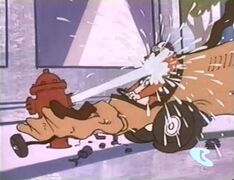 Motormouse has been out and about, and is whizzing back to the garage on his chopper, with a large box tied to the rear bar of the bike. Morning shift has already begun, and Autocat stands at the garage entrance, waiting for him. Despite it being business hours, Autocat decides to slam down a steel door over the garage entrance, to keep the little speedster out. Motormouse as usual takes this interruption in stride, and reaches for a remote control. He is one step ahead of Autocat, and has already installed in the steel construction his own personal garage door – of the doggy-type – which pivots open at the base of the larger door to admit the chopper – leaving the usual tread marks over Autocat’s person. Motormouse enters and skids to a stop inside his mousehole, where he reveals the secret of his surprise package. Inside is a bright red fire helmer, which Motormouse models to himself in a mirror, noting that this makes it official – he is now a volunteer in the local fire company. Autocat, watching through the hole, sees this development as inspiration for a new round of mouse-catching tactics. Hopping into a retro hot rod with roll bar, and hiding the vehicle behind a wall, Autocat produces a bell, and starts things off with a clanging false alarm. Motormouse helmets up and answers the call, zooming outside, while Autocat follows in his souped-up heap. Autocat believes all cams are firing so well, his beauty could catch Motormouse rolling in reverse – until gray smoke wafts into Autocat’s face, making him gasp and cough, and obscuring his vision. Autocat ducks under the smoke level to peer forward, and discovers the source of the smoke to be his own engine – and a burning clutch. Suddenly, it is not smoke blocking Autocat’s eyes, but water. Motormouse has stopped ahead, and hooked up a hose to a city hydrant, blasting Autocat and his engine to quench the smoke. Autocat’s passenger cab is flooded up to his waist, and Autocat complains what’s the big idea, reminding the mouse that cats hate water. Motormouse states he’s only performing his sworn duty, then speeds back to the garage to see if there are more calls. A dripping wet Autocat is forced to pull a bathtub plug from the bottom of his floorboards to let the cab drain itself dry.
Motormouse has been out and about, and is whizzing back to the garage on his chopper, with a large box tied to the rear bar of the bike. Morning shift has already begun, and Autocat stands at the garage entrance, waiting for him. Despite it being business hours, Autocat decides to slam down a steel door over the garage entrance, to keep the little speedster out. Motormouse as usual takes this interruption in stride, and reaches for a remote control. He is one step ahead of Autocat, and has already installed in the steel construction his own personal garage door – of the doggy-type – which pivots open at the base of the larger door to admit the chopper – leaving the usual tread marks over Autocat’s person. Motormouse enters and skids to a stop inside his mousehole, where he reveals the secret of his surprise package. Inside is a bright red fire helmer, which Motormouse models to himself in a mirror, noting that this makes it official – he is now a volunteer in the local fire company. Autocat, watching through the hole, sees this development as inspiration for a new round of mouse-catching tactics. Hopping into a retro hot rod with roll bar, and hiding the vehicle behind a wall, Autocat produces a bell, and starts things off with a clanging false alarm. Motormouse helmets up and answers the call, zooming outside, while Autocat follows in his souped-up heap. Autocat believes all cams are firing so well, his beauty could catch Motormouse rolling in reverse – until gray smoke wafts into Autocat’s face, making him gasp and cough, and obscuring his vision. Autocat ducks under the smoke level to peer forward, and discovers the source of the smoke to be his own engine – and a burning clutch. Suddenly, it is not smoke blocking Autocat’s eyes, but water. Motormouse has stopped ahead, and hooked up a hose to a city hydrant, blasting Autocat and his engine to quench the smoke. Autocat’s passenger cab is flooded up to his waist, and Autocat complains what’s the big idea, reminding the mouse that cats hate water. Motormouse states he’s only performing his sworn duty, then speeds back to the garage to see if there are more calls. A dripping wet Autocat is forced to pull a bathtub plug from the bottom of his floorboards to let the cab drain itself dry.
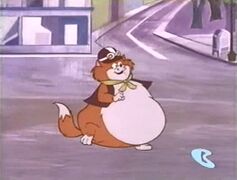 Autocat waits around the corner from the garage door, and again rings a false alarm bell. This time he waits in a modified dragster, which is equipped with “two blown mills, a tank full of methanol, and a little option called Automatic Karate Chopper!” At the nose of the vehicle are two large steel bars mounted sideways on pivots, each ending in a giant gloved hand in rigid Karate position, which, when activated, pound out an alternating series of slams ahead of the vehicle upon the ground. The chase is on as Motormouse exits the building. However, Motormouse takes a road that leads the two of them across the top of a municipal river dam. The pounding Karate chops are of such intensity, they fracture the road ahead of Autocat, and the structural integrity of the dam as well. A huge portion of the concrete wall below Autocat cracks away, sending his dragster and much of the river water flowing into the lowlands below. “How did I get into this?” speculates Autocat, as he shifts his vehicle into Fluid Drive. The huge chopping hands assume a different position, and try desperately to assume an overhand swimming stroke. But it is no use, as the car slowly begins to sink beneath the waves. “I’ve heard of an engine flooding, but this is ridiculous”, shouts Autocat, as his speech is cut off in bubbling gurgles while submerging.
Autocat waits around the corner from the garage door, and again rings a false alarm bell. This time he waits in a modified dragster, which is equipped with “two blown mills, a tank full of methanol, and a little option called Automatic Karate Chopper!” At the nose of the vehicle are two large steel bars mounted sideways on pivots, each ending in a giant gloved hand in rigid Karate position, which, when activated, pound out an alternating series of slams ahead of the vehicle upon the ground. The chase is on as Motormouse exits the building. However, Motormouse takes a road that leads the two of them across the top of a municipal river dam. The pounding Karate chops are of such intensity, they fracture the road ahead of Autocat, and the structural integrity of the dam as well. A huge portion of the concrete wall below Autocat cracks away, sending his dragster and much of the river water flowing into the lowlands below. “How did I get into this?” speculates Autocat, as he shifts his vehicle into Fluid Drive. The huge chopping hands assume a different position, and try desperately to assume an overhand swimming stroke. But it is no use, as the car slowly begins to sink beneath the waves. “I’ve heard of an engine flooding, but this is ridiculous”, shouts Autocat, as his speech is cut off in bubbling gurgles while submerging.
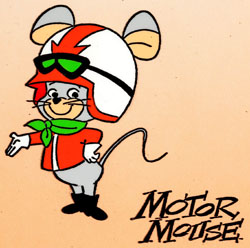 Autocat’s next mechanical marvel predicts “Star Wars” – consisting of a model T passenger cab set astride a set of eight mechanical legs ending in large army boots. “Now, I’ve got the most sure-footed vehicle around.” He takes it out for a “shake-down run”, observing that the shaking-up of himself in the cab lives up to its name. But no matter – the acid test is yet to come. In the road, Autocat observes a steel safe someone is in the process of moving. With a shift of a lever, Autocat sends the vehicle into a leap, its feet landing atop the safe with a mighty stomp. The vehicle jumps up and down repeatedly, flattening the steel safe like a pancake. Autocat returns to the garage, this time starting a small blaze to blow smoke into Motormouse’s hole to get him up and running. As the mouse zooms by, Autocat chuckles, “Okay Motormouse, time to put my foot down.” He tugs at his stick shift, but in his zeal yanks it loose. The mechanical legs twist every which way, tangling themselves in a mess that roughly resembles a pinwheel. “What a time to have eight left feet”, moans Autocat, as his walker collapses on its side, ejecting its driver. The cat lands next to the garage’s water cooler, and the 10 gallon jug lands over his head. Autocat splutters in unintelligible blubs from within the jug, only his last two words remaining audible – “HATE WATER!”
Autocat’s next mechanical marvel predicts “Star Wars” – consisting of a model T passenger cab set astride a set of eight mechanical legs ending in large army boots. “Now, I’ve got the most sure-footed vehicle around.” He takes it out for a “shake-down run”, observing that the shaking-up of himself in the cab lives up to its name. But no matter – the acid test is yet to come. In the road, Autocat observes a steel safe someone is in the process of moving. With a shift of a lever, Autocat sends the vehicle into a leap, its feet landing atop the safe with a mighty stomp. The vehicle jumps up and down repeatedly, flattening the steel safe like a pancake. Autocat returns to the garage, this time starting a small blaze to blow smoke into Motormouse’s hole to get him up and running. As the mouse zooms by, Autocat chuckles, “Okay Motormouse, time to put my foot down.” He tugs at his stick shift, but in his zeal yanks it loose. The mechanical legs twist every which way, tangling themselves in a mess that roughly resembles a pinwheel. “What a time to have eight left feet”, moans Autocat, as his walker collapses on its side, ejecting its driver. The cat lands next to the garage’s water cooler, and the 10 gallon jug lands over his head. Autocat splutters in unintelligible blubs from within the jug, only his last two words remaining audible – “HATE WATER!”
A streamlined aerodynamic rail is next off Autocat’s one-man assembly line – oddly started by use of an old fashioned handcrank in the rear. Autocat takes it out for another dry run. “Oh boy, what a bomb”, he laughs as the thing picks up speed. Unfortunately, it could probably use a drag chute, as once it gets going, it appears impossible to steer or stop. It thus crashes into a fire hydrant, water from which shoots in a gush directly into Autocat’s mouth. The cat is entirely unable to speak as the water fills him to the brim. A dissolve reveals Autocat walking away from the wreckage, his entire torso sloshing back and forth, inflated with about 50 gallons of water. “Now I know what a sponge feels like. I gotta find some place to dry out.” Autocat for once retreats to his home (an old shed on the edge of town) ahead of the 5 o-clock whistle, sitting in front of the flames of an old pot-bellied stove, and attempting to lick a case of persistent sneezing. “I hope I never see another drop of water as long as I live.” Who drives by, observing “more smoke”, but Motormouse. He mounts a ladder, and inserts his new fire hose into the stove’s chimney. The blast shoots out of the stove grill onto Autocat, as the water quickly fills the room. “No. Not that. No water”. Autocat gasps, as he struggles to keep his nose above the rising fluid, which passes the windows of the shed and approaches the ceiling. The front door bursts open, emptying the cabin of contents, including Autocat, who sits in a puddle, rising in attempt to brush the water out of his fur. Motormouse is surprised to find Autocat, and asks him if he saw how well his new hose worked. “I saw, I saw”, responds Autocat – then suddenly begins to shrink – down to a height of only about an inch. “You don’t look so good, Autocat”, notes Motormouse. “What do you expect?”, replies the cat, making as quiet an exit as he can. “I’m not pre-shrunk, you know. How embarrassing!”
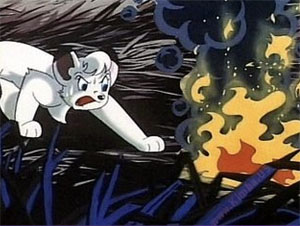 Our most dramatic entry of the week is an import from Japan, The Red Menace (Mushi Productions, Kimba the White Lion (aka “Jungle Emperor”), 8/31/66). An animal community from a neighboring jungle is threatened by a raging wildfire that erupts from a lightning strike. The local population flees for its life, a step ahead of the fast-moving fire-line and suffocating smoke. As was often the case with early anime, special-effects graphics and backgrounds are considerably good, well-chosen in color value, and give indication (especially in close imitation of some falling tree shots), that the animators had studied the work of the Disney artists in Bambi. From a far distance, Kimba, Dan’l Baboon, and others watch the tell-tale glow along the horizon, as Dan’l refers to the phenomenon as “The Red Menace” that has come again, and identifies the valley in which the fire must be raging. Kimba and some of his friends recognize that valley as the home of a small elephant they had once met and befriended (Peewee), who may be in danger. Kimba and his young friends race off toward the valley to offer help, while Dan’l, warning of danger to unlistening ears, resigns himself to the fact that “You might as well whistle in the wind as try and stop Kimba.” When the rescue party reaches the valley, they are almost trampled by an outbound herd of rhinos, as well as by many other animals fleeing the inferno. Coughing from the fumes, they call Peewee’s name everywhere, but see no sign of elephants. Their progress is turned back as they are almost caught in the blaze themselves when the wind shifts, dodging a hail of falling tree limbs. They retreat to a distant clearing to catch their breath, intending to resume their search momentarily, but unexpectedly find their quest at an end, stumbling upon the elephant herd in the open, having already escaped the forest, but lying exhausted upon the ground. Kimba is reunited with Peewee, whose excitement at the meeting only momentarily rejuvenates him – then, he stumbles to the ground again. The elephants’ exhaustion isn’t from the fumes or from running – but from the sheer lack of food, as the fire has consumed their usual food supply of tall grass. One of Kimba’s friends recalls a large open grassland not too far away, that should be more than abundant to supply the elephants’ needs, and the hope for food rouses the last bit of strength from the herd to rise and slowly trudge their way to the designated garden spot. The grasslands are indeed all that has been claimed, and Kimba’s friends pitch in to pull up grass as fast as the elephants can eat it, until all are nearly full. As Kimba and his pals tug at an exceptionally big clump of grass, they reveal that its size was due to something resting under it – a huge tusker bull elephant, who is the chief of another herd. (In corny fashion, as often occurred in the redubs of these early productions, the elephant speaks with an Irish accent, and is known as Kelly Phant.) Kelly objects to being disturbed, and even more so to finding Kimba has brought a strange herd to what he declares “his” lands. Kimba and his pals point out that the grass is so abundant here, there is obviously more than both herds could possibly need to sustain themselves, but Kelly insists his own herd was there first, and has no intention of giving up their territorial rights to strangers. Peewee’s herd is intimidated by Kelly’s unmoving stand, and backs down humbly, acknowledging that they will go. “Back to what?” asks Kimba, knowing their own feeding grounds are long gone. But no answer is provided to Kimba, as the massing forces of Kelly’s herd quickly cause the newcomers to retreat to a position of temporary safety back in Kimba’s jungle.
Our most dramatic entry of the week is an import from Japan, The Red Menace (Mushi Productions, Kimba the White Lion (aka “Jungle Emperor”), 8/31/66). An animal community from a neighboring jungle is threatened by a raging wildfire that erupts from a lightning strike. The local population flees for its life, a step ahead of the fast-moving fire-line and suffocating smoke. As was often the case with early anime, special-effects graphics and backgrounds are considerably good, well-chosen in color value, and give indication (especially in close imitation of some falling tree shots), that the animators had studied the work of the Disney artists in Bambi. From a far distance, Kimba, Dan’l Baboon, and others watch the tell-tale glow along the horizon, as Dan’l refers to the phenomenon as “The Red Menace” that has come again, and identifies the valley in which the fire must be raging. Kimba and some of his friends recognize that valley as the home of a small elephant they had once met and befriended (Peewee), who may be in danger. Kimba and his young friends race off toward the valley to offer help, while Dan’l, warning of danger to unlistening ears, resigns himself to the fact that “You might as well whistle in the wind as try and stop Kimba.” When the rescue party reaches the valley, they are almost trampled by an outbound herd of rhinos, as well as by many other animals fleeing the inferno. Coughing from the fumes, they call Peewee’s name everywhere, but see no sign of elephants. Their progress is turned back as they are almost caught in the blaze themselves when the wind shifts, dodging a hail of falling tree limbs. They retreat to a distant clearing to catch their breath, intending to resume their search momentarily, but unexpectedly find their quest at an end, stumbling upon the elephant herd in the open, having already escaped the forest, but lying exhausted upon the ground. Kimba is reunited with Peewee, whose excitement at the meeting only momentarily rejuvenates him – then, he stumbles to the ground again. The elephants’ exhaustion isn’t from the fumes or from running – but from the sheer lack of food, as the fire has consumed their usual food supply of tall grass. One of Kimba’s friends recalls a large open grassland not too far away, that should be more than abundant to supply the elephants’ needs, and the hope for food rouses the last bit of strength from the herd to rise and slowly trudge their way to the designated garden spot. The grasslands are indeed all that has been claimed, and Kimba’s friends pitch in to pull up grass as fast as the elephants can eat it, until all are nearly full. As Kimba and his pals tug at an exceptionally big clump of grass, they reveal that its size was due to something resting under it – a huge tusker bull elephant, who is the chief of another herd. (In corny fashion, as often occurred in the redubs of these early productions, the elephant speaks with an Irish accent, and is known as Kelly Phant.) Kelly objects to being disturbed, and even more so to finding Kimba has brought a strange herd to what he declares “his” lands. Kimba and his pals point out that the grass is so abundant here, there is obviously more than both herds could possibly need to sustain themselves, but Kelly insists his own herd was there first, and has no intention of giving up their territorial rights to strangers. Peewee’s herd is intimidated by Kelly’s unmoving stand, and backs down humbly, acknowledging that they will go. “Back to what?” asks Kimba, knowing their own feeding grounds are long gone. But no answer is provided to Kimba, as the massing forces of Kelly’s herd quickly cause the newcomers to retreat to a position of temporary safety back in Kimba’s jungle.
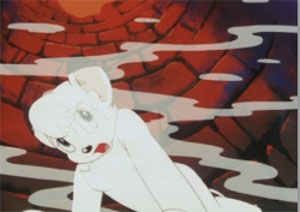 That night, Kimba and Peewee plot a desperate mission into Kelly’s territory, hoping to haul back as much grass as possible to feed the herd. They find the grasslands too well guarded by Kelly’s bull elephants and by spying hyenas, and are captured, taken to the palace of Kelly in the center of his lands. The palace appears to be the ruins of an old human castle, including one tall tower with an open turret at top, but no extant staircases within. Kelly orders the intruders to be punished by sealing them within the tower. Kimba and Peewee are thrown inside, then Kelly’s elephants slam repeatedly into the stone walls of the tower until enough stone and mud is dislodged from the tower turret to block off the entrance completely. Kimba and Peewee can find no way out, nor can manage any effect on the structural soundness of the tower from their own meager efforts to pound at its walls from inside. Suddenly, a call comes to Kelly from one of his sentries. The fire has again appeared on the horizon, spreading from the valley into Kelly’s territory at an alarming pace. Kelly and his herd are forced to abandon the palace, with no thought for the safety of Kimba and Peewee. The frightened duo within attempt to hold out, but drift into unconsciousness from the approaching smoke, which billows heavily over the turret opening above them.
That night, Kimba and Peewee plot a desperate mission into Kelly’s territory, hoping to haul back as much grass as possible to feed the herd. They find the grasslands too well guarded by Kelly’s bull elephants and by spying hyenas, and are captured, taken to the palace of Kelly in the center of his lands. The palace appears to be the ruins of an old human castle, including one tall tower with an open turret at top, but no extant staircases within. Kelly orders the intruders to be punished by sealing them within the tower. Kimba and Peewee are thrown inside, then Kelly’s elephants slam repeatedly into the stone walls of the tower until enough stone and mud is dislodged from the tower turret to block off the entrance completely. Kimba and Peewee can find no way out, nor can manage any effect on the structural soundness of the tower from their own meager efforts to pound at its walls from inside. Suddenly, a call comes to Kelly from one of his sentries. The fire has again appeared on the horizon, spreading from the valley into Kelly’s territory at an alarming pace. Kelly and his herd are forced to abandon the palace, with no thought for the safety of Kimba and Peewee. The frightened duo within attempt to hold out, but drift into unconsciousness from the approaching smoke, which billows heavily over the turret opening above them.
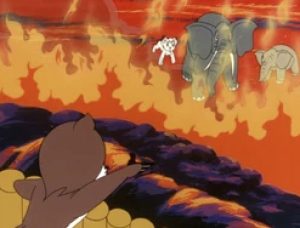 Back in Kimba’s jungle, the approaching fire is also noted by Dan’l and the others – as is the unexplained absence of Kimba and Peewee. Dan’l orders a tactical evacuation of the animals before things get any worse. Peewee’s mother, however, refuses to go, and begins searching in the opposite direction. A surprise change in the weather allows them all to eventually regroup, as a jungle rain seems to make the fire disappear – at least for the time being. A group of apes breaks through from the direction of Kelly’s territory with word from the grapevine that Kimba and Peewee were captured and taken to the palace. Peewee’s mother is the first to run toward the location, while Dan’l and the rest of the elephant herd quickly follow. They arrive to view the devastation that the fire has wrought to the area surrounding the palace, and the charring upon the walls of the still-standing tower. Hoping against hope that the two youths are still somewhere in the structure, the elephants amass their strength to break a hole in the side wall of the tower. The incoming blast of fresh air revives the prone Kimba and Peewee, and a happy reunion ensues, even Kimba rushing to embrace his mentor Dan’l, who he wondered if he would ever see again. Kimba apologizes for trying the risky mission. Dan’l consoles him: “You may have a foolish heart, Kimba, but it’s in the right place.” But trouble is far from over, as a new sighting of red glow nearby reveals the fire has sprung to life again from the embers. Everyone is about to flee in retreat, until Kimba gets an idea. He recalls that he and Peewee survived the fire because of the earth and stone surrounding them in the tower. Why not build a wall of earth and stone, to act as a barrier to stop the fire’s progress? Dan’l dampens his spirits with the realization that doing so takes time, which is something they don’t have. But the elephants, think otherwise. They work with a will to amass all the stones and earth they can dig up with their trunks and any implements they can hold to dig, while other herds such as hippos group to push in additional mounds of dirt.
Back in Kimba’s jungle, the approaching fire is also noted by Dan’l and the others – as is the unexplained absence of Kimba and Peewee. Dan’l orders a tactical evacuation of the animals before things get any worse. Peewee’s mother, however, refuses to go, and begins searching in the opposite direction. A surprise change in the weather allows them all to eventually regroup, as a jungle rain seems to make the fire disappear – at least for the time being. A group of apes breaks through from the direction of Kelly’s territory with word from the grapevine that Kimba and Peewee were captured and taken to the palace. Peewee’s mother is the first to run toward the location, while Dan’l and the rest of the elephant herd quickly follow. They arrive to view the devastation that the fire has wrought to the area surrounding the palace, and the charring upon the walls of the still-standing tower. Hoping against hope that the two youths are still somewhere in the structure, the elephants amass their strength to break a hole in the side wall of the tower. The incoming blast of fresh air revives the prone Kimba and Peewee, and a happy reunion ensues, even Kimba rushing to embrace his mentor Dan’l, who he wondered if he would ever see again. Kimba apologizes for trying the risky mission. Dan’l consoles him: “You may have a foolish heart, Kimba, but it’s in the right place.” But trouble is far from over, as a new sighting of red glow nearby reveals the fire has sprung to life again from the embers. Everyone is about to flee in retreat, until Kimba gets an idea. He recalls that he and Peewee survived the fire because of the earth and stone surrounding them in the tower. Why not build a wall of earth and stone, to act as a barrier to stop the fire’s progress? Dan’l dampens his spirits with the realization that doing so takes time, which is something they don’t have. But the elephants, think otherwise. They work with a will to amass all the stones and earth they can dig up with their trunks and any implements they can hold to dig, while other herds such as hippos group to push in additional mounds of dirt.
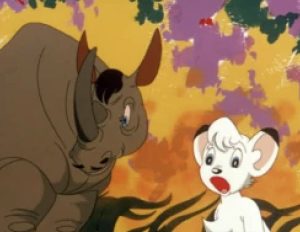 As work is just progressing, a bird brings word that Kelly’s herd has become trapped close to the fire. Kelly beats out flames frantically with branches held in his trunk to clear a path for his herd, but falls himself, his leg getting caught between two rocks. Kimba and Peewee take time out to make a rescue while the others continue with the wall, freeing Kelly’s leg just before the flames hit. The only way back to safety is a jump over an already-constructed portion of the wall – too much for Kimba or Peewee, but manageable for Kelly when he places the two of them atop his back, to return the favor of having his life saved. Time is quickly running out, and the wall is not finished, but Kelly pledges the assistance of his herd. With their massed strength, the animals group in a solid body, taking up some large doors they find in the human compound to use to create a shoveling blade ahead of them. Kimba, Peewee, and the smaller animals add their efforts to brace the door plates up, standing on the elephants’ heads, and the massed body moves forward, trenching into the earth, and pushing upwards around them a large line of earth and rock, until it towers to slightly above their own height. The charging animals gain momentum, and soon are moving at a good clip, raising a powerful dust and leaving a high wall of debris all around them. They proceed ahead in a line following the terrain, in the general direction of a lake, hoping to cut off the fire’s progress at the water’s edge. The fire, however, is just as persistent, and gaining fast. It’s a close race to the wire, but the animals reach the shoreline first, darting out the end of the debris line to duck behind it, waiting for the fire to hit. The fire line collides with the wall, and nearly leaps over its top as the animals retract in fear – but the wall holds, and, little by little, the fire runs out of fuel, and begins to recede. Kelly asks forgiveness for his selfishness, and with still enough of his lands saved to provide for all, invites Peewee’s herd to stay. But the visiting herd will stay only long enough to recoup their strength, and head back toward their homelands, with the inspiration to seek out new feeding grounds and rebuild their old lands as best they can, inspired by Kimba’s can-do philosophy. Kimba and his subjects bid Peewee’s herd well as they depart, their hopes alive with promise for the future.
As work is just progressing, a bird brings word that Kelly’s herd has become trapped close to the fire. Kelly beats out flames frantically with branches held in his trunk to clear a path for his herd, but falls himself, his leg getting caught between two rocks. Kimba and Peewee take time out to make a rescue while the others continue with the wall, freeing Kelly’s leg just before the flames hit. The only way back to safety is a jump over an already-constructed portion of the wall – too much for Kimba or Peewee, but manageable for Kelly when he places the two of them atop his back, to return the favor of having his life saved. Time is quickly running out, and the wall is not finished, but Kelly pledges the assistance of his herd. With their massed strength, the animals group in a solid body, taking up some large doors they find in the human compound to use to create a shoveling blade ahead of them. Kimba, Peewee, and the smaller animals add their efforts to brace the door plates up, standing on the elephants’ heads, and the massed body moves forward, trenching into the earth, and pushing upwards around them a large line of earth and rock, until it towers to slightly above their own height. The charging animals gain momentum, and soon are moving at a good clip, raising a powerful dust and leaving a high wall of debris all around them. They proceed ahead in a line following the terrain, in the general direction of a lake, hoping to cut off the fire’s progress at the water’s edge. The fire, however, is just as persistent, and gaining fast. It’s a close race to the wire, but the animals reach the shoreline first, darting out the end of the debris line to duck behind it, waiting for the fire to hit. The fire line collides with the wall, and nearly leaps over its top as the animals retract in fear – but the wall holds, and, little by little, the fire runs out of fuel, and begins to recede. Kelly asks forgiveness for his selfishness, and with still enough of his lands saved to provide for all, invites Peewee’s herd to stay. But the visiting herd will stay only long enough to recoup their strength, and head back toward their homelands, with the inspiration to seek out new feeding grounds and rebuild their old lands as best they can, inspired by Kimba’s can-do philosophy. Kimba and his subjects bid Peewee’s herd well as they depart, their hopes alive with promise for the future.
Watch this episode on Pluto TV.
NEXT WEEK: Warner and Disney (among others) enter the daily TV fray.


 Charles Gardner is an animation enthusiast who toils by day as a member of LA Law – but by nights and weekends indulges in classic jazz and ragtime as a performer; and studies classic Hollywood cartoons… maybe a little too much.
Charles Gardner is an animation enthusiast who toils by day as a member of LA Law – but by nights and weekends indulges in classic jazz and ragtime as a performer; and studies classic Hollywood cartoons… maybe a little too much.


































































































































































Gumby would later break out his fire engine again in “Mysterious Fires” and “Gumby’s Fire Department” (both 1957), with superior production values to his initial “Moon Trip”.
The sitcom that Marty Ingels co-starred in was “I’m Dickens, He’s Fenster,” not “Fester”. Fester was in another show with John Astin. In addition to playing Fenster, Ingels was in the 1975 softcore sex comedy “Linda Lovelace for President” alongside Micky Dolenz, Joe E. Ross, Chuck McCann, Stafford Repp, and other icons of 1960s television comedy. I have absolutely no recollection of “Motor Mouse and Autocat”; that was the trouble with having three networks running cartoons simultaneously on Saturday mornings — it was impossible to avoid missing out on something good. I do, however, remember that Shasta cola commercial. It sounds like Tom Bosley doing the voiceover.
Laurel and Hardy’s fire chief in “False Alarms” seems to be saying “Mmmm, mellow!” in reference to his pipe tobacco. On the other hand, he might just as well be saying “Mmmm, Mello!” referring to composer Jack de Mello, who composed the musical cues used in many Hanna-Barbera productions of the mid-1960s, including this one.
I recall another episode of Kimba in which a film director set fire to the jungle just to create a dramatic scene for his movie.
Yeah, I like Motor Mouse and Autocat too. I feel like Maltese must’ve wrote it. I recall seeing it on H-B’s early ’90’s part live-action seires “Wake, Rattle, and Roll) on the Disney Chanel. It rotated with Avery’s Dino and Cavemouse and the in-famous Undercover Elephant.
Are you sure that you remember “Motormouse and Autocat” on “Wake, Rattle, and Roll”? Wikipedia’s article on that series doesn’t mention it, though it references the other two fillers. Could you be confusing it with the original “Fender Bender 500” segments produced for the show – a sort of “Wacky Races” revisit incorporating the classic H-B animal characters of the 1960’s? Motormouse wouldn’t seem a good fit side by side with those cartoons, making the program too automotive in slant overall.
Maybe I am a bit confused there. I might be mixing my memories of that show and Cartoon Network where “Motormouse” aired fequently (although, I swear I saw those shorts before CN launched).
Motormouse and Autocat were pitched as “a motor racing version of Tom and Jerry” with the main characters designed by Jerry Eisenberg, possibly in cooperation with Iwao Takamoto.
I seem to remember some parents’ groups criticizing “Motormouse and Autocat” for promoting “reckless driving,” presumably thereby encouraging kids for do so when they eventually got their licenses.
Gumby being pushed through that hospital corridor is one of the eeriest moments in TV kids’ cartoon.
You ain’t whistling “He was once a little green slab of clay.” I wouldn’t recommend letting a child watch it alone in a dark room unless you’re ready to spring for heavy therapy. (No wonder its original young viewers became druggie hippies a decade later.) The whole sequence is like a low-budget psychodrama. Somehow Gumbo’s and Gumba’s smiles seem downright sinister; the creepy electronic music doesn’t help, either.
I was always enchanted by those early Gumbys. Having seen Moon Trip numerous times (in black and white on Boston’s channel 4), I’d never known it was the first one. Indeed, there was no need to explain Gumby’s world, you just watched and it became clear.
Seeing it now, it impresses me how well-planned it is, a shot-by-shot continuity that is never rushed and never confusing. I appreciate the original way special effects are achieved on a low budget – scratching the emulsion makes rocket flames, hand-drawing smoke with India ink, painstaking but effective. And the moon creatures’ voices, which sound like someone rubbing a balloon.
Here’s an odd half-baked scenario, inspired by Nic Kramer’s comments. Suppose Motormouse and Autocat had been better remembered alongside H-B’s other legendary animal stars. It would have seemed almost a requirement that they be invited to participate in the Fender Bender 500, being the only genuinely automotive animals in the H-B stable. But what could their role have been? They were not strangers to racing, having competed in one race in the series (where Autocat, despite his foul-ups, actually receives a runner-up trophy). But, as each of the vehicles in the Fender Bender carried two team members, MM and AC would have had to work together. This I could see to a point, AC handling design and operation, with MM handling maintenance and quick-thinking emergency repair. However, would MM”s squeaky-clean racing ethics have stood for AC’s inclination toward sneakiness in design? AC was a consummate professional in handling his job, so I presume he might have been capable of adapting toward the more purely inventive (like Pat Pending) over the diabolical if he really wanted to (while, of course, his rival racer Dastardly could never have resisted the temptation to win by nefarious means). The problem might have been that MM and AC’s combined knowledge would have made them unstoppable against the other contestants – including Dick Dastardly. God forbid, however, if Dastardly ever managed to get AC working for him on his pit crew! You also wouldn’t have wanted AC up to his usual motivations to catch MM during a race, as his and Dastardly’s cross-purposes would easily negate each other, in the same manner as Sylvester’s and Wile E. Coyote’s respective failures in “The Wild Chase”. Maybe MM and AC outclass the rest of the racers, and might serve best as sponsors/officials/referees of the events, MM being an expert in watching that things proceed according to the rules of fair play, and AC the whiz at detecting foul driving techniques or illegal equipment modifications (if any such restrictions exist), to keep the races progressing smoothly (making them both unpopular characters in Dastardly’s book, and possibly leading to DD planning some harmful fate for them as well).
“The Fire Phantom” (Filmation, New Adventures of Superman, 5/11/66): While Clark Kent and Jimmy Olsen are on a fishing trip outside Metropolis, a strange being of living fire from the earth’s core emerges from a disused mine shaft and ignites everything it touches. As the forest burns, Clark transforms into Superman, rescues Jimmy from the blaze, and then battles the fiery monster. Turns out that ordinary pond water is the Fire Phantom’s kryptonite.
In “Dibble Sings Again” (Hanna-Barbera, Top Cat, 4/4/62), Top Cat cons Officer Dibble into hiring him as his agent, to help fulfill the officer’s dream of being a famous singer on television. A burning building just down the street, with a TV crew filming the proceedings, provides the first opportunity. T.C. and the gang wheel an upright piano in front of the cameras, and Dibble pops out of it like a Jack-in-the-box to sing a chorus of “Camptown Races”. But the fire chief yells at him for getting in the way, and tells one of the firefighters to give Dibble a blast from the hose. Meanwhile, a falling ember burns through the TV crew’s broadcast cable, so Dibble’s performance never makes it to air anyway.
In the very next scene, a drenched Dibble is trying to dry himself in front of an open fire in the alley. Funny, you’d think there’d be a city ordinance against that.
I was moved by your comment about Motormouse and Autocat, I had the chance to watch some episodes of this cartoon and I thought they were very fun characters (I think this is also because I’m a fan of this Ralph Wolf/Sam Sheepdog dynamic that they share). This gave it a certain distinction from other cat and mouse cartoons that Hanna-Barbera was producing after the success of Tom and Jerry and is the first one that I felt sympathy for on both sides, since deep down they are “friends” with in a certain way. I wish Warner paid attention to these old Hanna-Barbera shows like Quick Draw McGraw or Cattanooga Cats itself, of which M&A are part, I hope there are plans for them to release all segments of these shows on blu-rays in the future.